Tuesday, July 31, 2012
Monday, July 30, 2012
Sportsman's Daughter

Saturday, July 28, 2012
Manchester Book Signing Pics
Friday, July 27, 2012
Here's the info: Waterstone's, Trafford Centre, Barton Dock Road, Manchester, M17 8AA (0161 749 8623) from 11am until 4pm.
Click here for all of my 2012 signings
Shaun Attwood
Thursday, July 26, 2012
Rheingau Musik Festival, Windsbacher Knabenchor at Wiesbaden Marktkirche
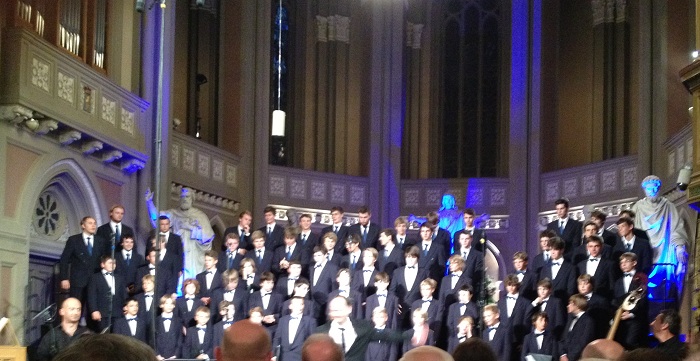
N aturgemäß dirigiert er [Lehmann] anders als sein Vorgänger Karl-Friedrich Beringer, aber mit nicht minder intensiver „sprechender” Gestik und Mimik... enorm saubere Intonation, ausgereifte, homogene und ergreifende Piani, flexible Phrasierung, aber auch, wenn nötig, ein raumgreifendes, sattes Fortissimo... ist diese Perfektion nicht Selbstzweck, sondern dient dem musikalischen Ausdruck, der Textausdeutung, der Architektur des Stücks.
[Naturally, Lehmann conducts differently than his predecessor, Karl-Friedrich Beringer, but with no less intense ‘talking’ gestures and facial expressions than he... enormous clean intonation, mature, homogeneous and poignant piani, flexible phrasing, but also, as necessary, an expansive, lush fortissimo... This perfection is not an end in itself but serves the musical expression, the interpretation of the text, the architecture of the piece.]”
— Klaus Kalchschmid, Süddeutsche Zeitung, 07-MAY-2012.
S ing Bach and Mendelssohn in the dwindling twilight, with your dark blue suits and brilliant white shirts and long necktie or bowtie depending on your tenure with the choir.
S ing without ambition or guile. Sing like your sound can fix all that is wrong with the world, as it seems now very plausible to us in the audience that it can. Yes, we are sure of it.
O h, and yes, sing, if you can manage it, when your choirmate behind you on the 5-tier risers has just had the audacity/impudence to hoist your underwear and give you a ‘snuggy’ while Martin Lehmann is looking down at his score preparing to embark on the next piece, in this concert that is being recorded for CD. The smiles of your neighbors reveal how hard it is for them to maintain their facial and vocal composure amid such hilarity and extreme risk.
Y ou and some of your fellow singers in the choir have dead-on perfect pitch; some have a vocal maturity beyond their years; some of the younger ones have an innocent sound that will soon be lost as their experience of the world accumulates.
T he unstoppable beauty of your sound in this 2-hour concert is nearly impossible for us to bear. Afterward, we walk in the dark over the cobblestones back to our hotel and think about this, grateful for the sonic/spiritual gift you have given to all of us—a miracle of Olympic-level vocal performance and musicianship that seemingly has come without sacrifice of your ineffable boyness or your individual truth.
- Windsbacher Knabenchor website
- Windsbacher Knabenchor. Kein Schoner Land: Deutsche Volkslieder. (Sony, 2012.)
- Windsbacher Knabenchor. Bach: Wie schön leuchtet der Morgenstern. (Sony, 2012.)
- Martin Lehmann (artistic director/conductor) page
- Rheingau Musik Festival website
Holy Dog Water
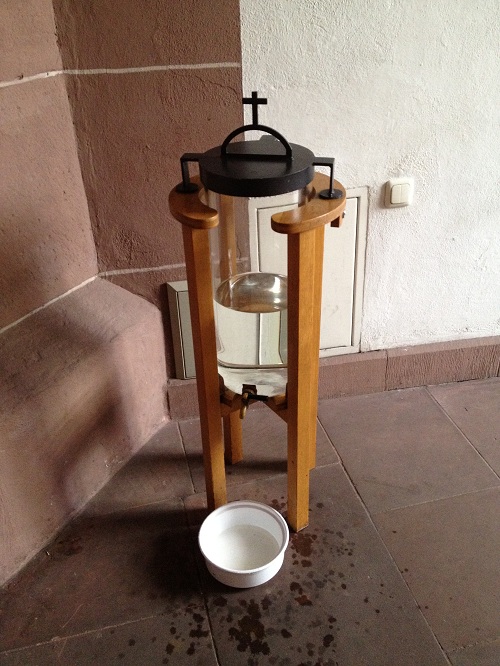
Wednesday, July 25, 2012
Rheingau Musik Festival, Piano Trio at Schloß Johannisberg

W hen the unexpected and non-functional seventh chords of mm. 5-6 yield to the relatively stable A minor of m. 7, the significant aural affect is heightened...”
— William Hussey, MTO 2003;9(1).
T he performance last evening (of Shostakovich’s Op. 67 in E minor and Tchaikovsky’s Op. 50 in A minor) at Schloß Johannisberg by the piano trio comprised of Erik Schumann (violin), Leonard Elschenbroich (cello), and Anna Vinnitskaya (piano) was exceptionally good. These artists, each of whom is approximately 30 years old and each already with a number of competition wins and honors and awards behind them, are superbly matched to each other in terms of their musical vision or interpretive conception of each of these pieces and in terms of their playing style. That they thoroughly enjoy playing together is palpable and plain for all to see in performances like the one in the Fürst von Metternich Saal last night.
I n the last movement of the Tchaikovsky, Schumann broke a string. The music stopped, and the audience was expecting some confusion on stage—at least a 10-minute break while the string was replaced. The trio exited the stage, and we were astonished to see them return less than 3 minutes later, the violin re-strung and tuned. They took the last movement again in stride—with expressive coherence and emotional continuity as if no interruption, no catastrophe of breaking a string had taken place. Tremendous!
T he entire performance was admirable, but, for me, the poignancy of the first movement of the Shostakovich—and of the passacaglia—was especially compelling emotionally. The high-pitch harmonics in Elschenbroich’s walking figures at the beginning, with Schumann’s violin notes much lower, and Vinnitskaya’s piano in the depths below that—create a sense of profound danger and loss: as if denoting a war-time sorrow that has not fully registered with those who have experienced the loss, and as if it will take a lifetime to register it. The techniques include artificial harmonics excited at intervals other than a fourth. Different artificial harmonics can be produced by touching a perfect fifth above the stopped pitch, which sounds an octave higher than the note under the touched node. Another artificial harmonic is sounded by touching a major third above the stopped pitch, which then sounds two octaves above the lightly-touched spot on the fingerboard. Naturally, the pitches of these high-register harmonics are far less precisely controllable than ordinary stops in normal register—so the expressive effect is one of scary tight-rope walking, or great anxiety, or coping under great pressure and external constraints.
T he linear chromatic lines and their mercurial, untrustworthy melodic direction beg the questions ‘Where will the line end? Will it end?’ This cadence created by melodic contrast opposes traditional diatonic cadence mechanisms and tampers with our emotions. Hussey terms this ‘cadence by contrast’ in his analysis of the passacaglia in Shostakovich’s Op. 67, and, based on the experience of last night’s concert, we can say that when it is executed with conviction it is a really powerful rhetorical device!
T he slippery, descending chromatic bass lines in the cello and the piano erode our sense of certainty and demolish any comfort zone to which we might nostalgically have hoped to cling. This piano trio is, to me, Shostakovich in 1944 describing the conjectured future, now become our present 70-years-on fully-materialized reality. No more conjectures; no more chances to choose again.
T here are exuberant, happy figures in Op. 67, to be sure. But the overall effect of these, juxtaposed with the poignant and tenuous content, is ironical or backhanded horror-inducing. Fantastic performance; we went home with lots to absorb and think about!
- Erik Schumann website
- Leonard Elschenbroich website
- Anna Vinnitskaya website
- Rheingau Musik Festival website
- Fanning D, ed. Shostakovich Studies. Cambridge Univ, 2006.
- Kuhn J. Shostakovich in Dialogue. Ashgate, 2010.
- Sheinberg E. Irony, Satire, Parody and the Grotesque in the Music of Shostakovich. Ashgate, 2001.
Buddies With Benefits




 One unique benefit of hanging around other sportsmen and hunters is the gift of game meat. There are many tired old jokes about not being able to give away extra fish one has caught. Such is never the case when one of your gang kills a wild boar.
One unique benefit of hanging around other sportsmen and hunters is the gift of game meat. There are many tired old jokes about not being able to give away extra fish one has caught. Such is never the case when one of your gang kills a wild boar.Tuesday, July 24, 2012
Sports Advice
From Frankie (Letter 17)
Frankie - A Mexican Mafia hit man and leader of prison “booty bandits,” who saw me rubbing antifungal ointment on the bleeding bedsores on my buttocks at the Madison Street jail, and proposed we have a gay prison marriage.
Monday, July 23, 2012
Music in the Vineyards: Rheingau Festival ‘Musiker in Weingütern’
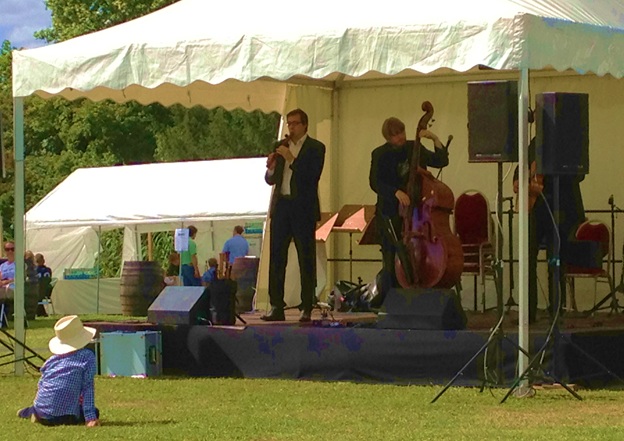
D rei Musiker - eine Mission: Die Befreiung der Blockflöte vom schäbigen Ruf eines Kinderspielzeugs! [Three musicians, one mission: Liberation of the recorder from its seedy reputation as a children’s toy!]”
— Wildes Holz.
S ometimes an event is just so good you have to pinch yourself to check whether or not you are dreaming. That is surely the case for the ‘Musiker in Weingütern’ events, part of the Rheingau Festival near Frankfurt/Wiesbaden. The performance I attended yesterday at Weingut Baron von Knyphausen was full, approximately 2,000 people attending at 32 euro each = €64K ticket sales, plus concession sales.
S eating was at well-shaded picnic tables with benches seating 8 persons per bench, 16 persons per table. The picnic tables were arranged under a U-shaped configuration of large wind- and weather-proof tents, with the stage in the center of the U. On each side of the U, the tables were deployed with their long axis pointing toward the stage. The grass aisles between adjoining tables were wide enough to enable attendees to quietly and easily come and go without disturbing their neighbors. Each table was numbered, and each numbered seat was assigned and ticketed—so that attendees purchasing tickets were able to select the location and price-level of seating they preferred, in just the same way as they would for a concert in a concerthall—with the assurance and peace-of-mind that they will not be subjected to a jostling free-for-all, of the sort that is associated with ‘general admission’ to a sold-out performance.
T he geometry of the tables and benches arranged in this manner meant that every member of the audience had one shoulder toward the stage (or else straddled the bench or rode the bench side-saddle to face the stage) and had a fine view of the performers throughout.
T he performance began at 16:00 sharp and continued until 20:00. Children played in the grassy space in front of the stage. Despite vigorous play, not once was there noise or rough-housing; not once did a parent have to collar a child to stop any misbehavior. The adults consumed generous quantities of wine but not one became loutish or disruptive. In short, a wonderful afternoon was had by all!
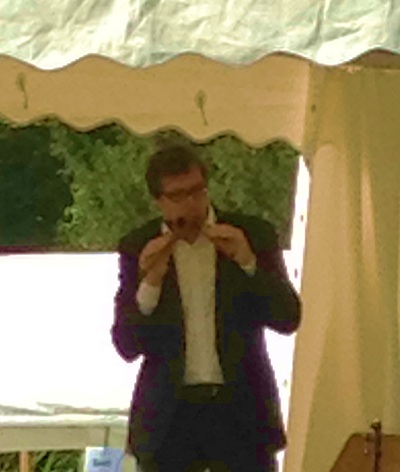
E ach of 4 ensembles played for 35 minutes with 25 minutes interval for set-up and sound-checks for the next group, during which the attendees had ample time to go to the concession tables and buy food, wine, and water. Sound reinforcement was expertly done, with excellent miking and engineering from the mixing deck, and sufficient monitor speakers arrayed all around the tent area.
T he tents and awnings were of extremely heavy-weight vinyl-coated materials, so that even in a 5km/hr light breeze they made absolutely no flapping or extraneous noise.
T o make this sort of a 4-hour collaboration succeed, the following elements are essential:
- Musical repertoire must be relatively robust (not ‘loud’ surely, but with tempi and phrasing that will be gesturally clear even under less-than-ideal acoustical conditions), so that the sound reinforcement will be adequate to enable the performers to be understood without listener annoyance, even if there is some wind.
- Musicians must possess abundant poise and confidence to face unexpected contingencies gracefully and with humor.
- Catering and front-of-house staff must be knowledgeable, skillful, and energetic in their roles. They must behave as though their employment depends on their performance. Presenters: Do not imagine attempting an event of this size and complexity with volunteer or trainee resources or staff who have a laid-back or entitlement attitude, or who cop a touchy ‘artistic temperament’ when they are in contact with the public.
- Food and beverage concessions must offer a menu with a wide variety of choices ranging from small snacks to mains and desserts, deliver them rapidly to customers (from steam-tables and other logistically efficient equipment), and handle cashier operations swiftly.
- Lavatory facilities should be dispersed throughout the periphery of the venue, so that access is quick and reasonably dignified for all attendees regardless of their seating location and queues do not form. Wineries are accustomed to catering large events with substantial ingress and egress of fluids and are expert in maintaining appealing aesthetics with these necessary functions. This is no time for cheap, smelly temporary johnny-on-the-spot sheds.
A n event like this has, I would say, approximately equal opportunities and risks for the winery and for the performers. The attendees and their word-of-mouth social network communications about their wine-music experience are a portal to viral opinions about both products—the wine and the music. Both products face intense competition and market-saturation. And, to be honest, both products tend to address market segments that are somewhat older—35 years and up. There should be more music-wine events like this! (There are a few, such as Music in theVineyards Festival in St. Helena, California, and Huntington Estate Festival in New South Wales.) But there is an unmet need here. There should be far more events like these! In summary, [chamber/small-ensemble] music-in-vineyards is a perfect blend, and Weingut Baron Knyphausen and the ensembles yesterday harmonized perfectly on this sunny Sunday in July, to the total pleasure and memorable benefit of all.
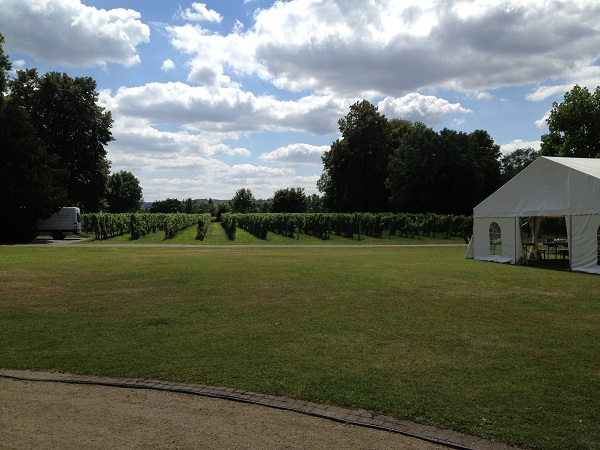
- Wildes Holz website
- Vano Bamberger Ensemble
- CriCri Brasil
- Frankfurt Swing All Stars
- Weingut Baron Knyphausen
- Rheingau Musik Festival
- Hall C, Mitchell R. Wine Marketing: A Practical Guide. Butterworth-Heinemann, 2007.
- Higgs D. Effective Tweeting For Wineries: A Guide to Wine Marketing on Twitter. ADS, 2012.
- Lapsley J, Moulton K. Successful Wine Marketing. Springer, 2001.
- Resnick E. Wine Brands: Success Strategies for New Markets, New Consumers and New Trends. Palgrave-Macmillan, 2008. (pp. 108ff on music tie-ins)
- Thach L. et al. Wine Marketing & Sales: Success Strategies for a Saturated Market. Wine Appreciation Guild, 2007.
- GreatWineCapitals.com
Sunday, July 22, 2012
Boxing News
 I have not given you much in the way of boxing news of late. However, I am thrilled to report the Heavyweight I manage, Joey Cusumano, was victorious last evening. He scored a 1st round Knockout at a small boxing venue in North Carolina. He is now 4-1 and this was another small step on the path to a shot at a World Title. stay tuned.
I have not given you much in the way of boxing news of late. However, I am thrilled to report the Heavyweight I manage, Joey Cusumano, was victorious last evening. He scored a 1st round Knockout at a small boxing venue in North Carolina. He is now 4-1 and this was another small step on the path to a shot at a World Title. stay tuned.Saturday, July 21, 2012
Martin Stadtfeld: Inspired Runtime Indirection

T he Busoni transcription is] absorbed in itself, moving round itself, decidedly turned away from the world... brooding; Beethoven-ish.”
— Hugo Riemann.
M artin Stadtfeld’s performance of Mendelssohn’s Klavierkonzert Nr. 1 g-Moll op. 25 with Sir Neville Marriner and Academy of St. Martin in the Fields at the Rheingau Festival was exceptional—a young man’s composition, performed with a young person’s sensibilities and energy. It simply sang!A lthough Bach set verses from Luther’s ‘Nun komm, der Heiden Heiland’ nine times, many of the same Advent themes run through all the settings. Subtle nuances and theological allusions point to various verses of the chorale text, and the cantatas remain a starting point for the interpretation of the organ works.”
— Anne Leahy, in Zager, p. 95.
B ut Stadtfeld’s 4’30” encore (Ferruccio Busoni’s transcription of J.S. Bach’s BWV 659 ‘Nun komm, der Heiden Heiland’) revealed a maturity and grasp of life’s setbacks and aporias: it was teleological, driving purposefully toward its goal(s) with pragmatism and propensity toward acceptance, yet with an open-heartedness/open-mindedness that still has room for hope.
S tadtfeld’s left-hand is quiet... ‘reticent’, as recommended in the performance notes in the original Breitkopf & Härtel edition of Busoni... enabling his melodic right-hand to have the terse prominence it requires. The tenuto and agogic accenting in the right-hand, in turn, conveys motives that are… pregnant.
T he expectancy was such that Stadtfeld impressed us that he himself was discovering things as he went, even though he has performed this prelude many, many times in the past... ‘sehr ausdrucksvoll mit vollem Anschlag.’ Many notes—the touch he applied to them—were, to me, like variable values in a software module that were resolved and bound at Stadtfeld’s pre-concert preparation—at ‘compile-time,’ so to say. But there were equally many that are only resolved on a moment-by-moment basis during performance (runtime). The balance between these lent a tremendous liveliness and interest and vibrancy to the performance of this beautiful Busoni transcription.
I t is, for me, analogous to the difference in software between a layered design with subroutines and an object-oriented design with event-handler methods. The terseness of the left-hand is such that Stadtfeld expresses not a human resoluteness but instead a process in Nature, something that is immutable, like mortality; not at all deterministic, but inevitable in the sense that human wishes and intentions cannot change the outcome.
I n software engineering terms, the Busoni-Bach left-hand module is a ‘wrapper’ and encapsulates the right-hand module. The left-hand ‘service’ owns a set of ‘objects’ with ‘handlers’ that share the same state. State is possible to preserve across invocations as the figures recur over the 3 pages of this transcription. It lends nicely to cooperation through message passing communication. Stadtfeld’s multiple levels of runtime indirection... reveal the extent and fate of our wishing and desiring.
E ach object has three parts: a component implementation, an export interface, and an import interface. Export and import can be modeled with runtime constructs specifically designed for component wrapping and interface adaptation, such as interception techniques for runtime resolution. The trills, for example, amount to handshake interfaces between right-hand and left-hand parts.
L iabilities of interpretations that entail generous amounts of runtime indirection include (1) variation-point management [adding and binding variants at a late moment in time implies extra work for managing and implementing variation points] and (2) predictability [a large amount of variability makes it virtually impossible to test all combinations during rehearsal]. But the merits of ‘romantic,’ liberal runtime indirection include danger, surprise, and excitement of the sort we were thrilled by on hearing Stadtfeld’s inspired performance of this Busoni-Bach ‘Nun komm’ Zugabe. A tiny encore that emotionally surpassed the gifts of the excellent, larger concerto that preceded it. Bravo!

- Martin Stadtfeld website
- Rheingau Musik Festival
- Stadtfeld M. Bach: Piano Concertos: No. 2. (Sony, 2011.)
- Ferruccio Busoni (1866-1924) transcription of J.S. Bach Orgelchoralvorspiel "Nun komm, der Heiden Heiland" BWV 659 (Come, Savior of the Gentiles) at Klavier-Noten.com
- Rösel P. Ferruccio Busoni: Klavierbearbeitungen Bach'scher Werke. (Berliner Klassic, 1994.)
- Vladimir Horowitz YouTube video of Busoni transcription of Bach BWV 659.
- Viktors Berstis YouTube video of Busoni transcription of Bach BWV 659.
- Brendel A. Ferruccio Busoni: Klavierbearbeitungen Bach'scher Werke. (Philips, 2006.)
- Lipatti D. Ferruccio Busoni: Klavierbearbeitungen Bach'scher Werke. (Regis, 2006.)
- Busoni F. J.S. Bach: Orgel-Choralvorspiele für Klavier, Heft 1. (Breitkopf & Härtel, 1898)
- Busoni F. J.S. Bach: Orgel-Choralvorspiele für Klavier, Heft 1. (Breitkopf & Härtel, 1898) at SheetMusicPlus.com
- Busoni F. J.S. Bach: Orgel-Choralvorspiele für Klavier page at IMSLP.org
- One More Level of Indirection at c2.com
- Cooper K, Torczon L. Engineering a Compiler. 2e. Morgan-Kaufmann, 2011.
- Goedicke M, et al. Design and implementation constructs for the development of flexible, component-oriented software architectures. In Proc 2nd Intl Symposium on Generative and Component-Based Software Engineering (GCSE’00), Erfurt, Germany, OCT-2000.
- Lienhard A. Dynamic Object Flow Analysis. Lulu, 2009. (p. 34)
- Spring J, et al. Reflexes: Abstractions for integrating highly-responsive tasks into Java applications. ACM Trans Embedded Comput Sys 2010;10(4):1-29.
- Zager D, ed. Music and Theology: Essays in Honor of Robin A. Leaver. Scarecrow, 2006.

M athematics is the heart and soul of music … Without question the bar, the rhythm, the proportion of the parts of a musical work and so on must all be measured … Notes and other signs are only tools in music, the heart and soul is the good proportion of melody and harmony. It is ridiculous to say that mathematics is not the heart and soul of music.”
— Johann Mattheson, 1743, ‘Neu eröffnete musikalische Bibliothek’ 2:54.
Thursday, July 19, 2012
Visiting Death Row (by Charlotte)
Tuesday, July 17, 2012
Canine Commandments
 One of the Sporting/Hunting sites I follow posted this very relevant list of rules. particularly relevant are No.s 4 and 10. Many dog owners like the concept but not the responsiblity. They take no time to train the dog or spend sufficient time interacting. Then they wonder why the dog is ill-mannered and misbehaves. If you do not know how to train a dog...LEARN. Most areas have dog training classes and clubs to teach you how to teach your dog.
One of the Sporting/Hunting sites I follow posted this very relevant list of rules. particularly relevant are No.s 4 and 10. Many dog owners like the concept but not the responsiblity. They take no time to train the dog or spend sufficient time interacting. Then they wonder why the dog is ill-mannered and misbehaves. If you do not know how to train a dog...LEARN. Most areas have dog training classes and clubs to teach you how to teach your dog.No. 10 made me choke up. As you may recal I posted a while back about holding my dear Dixie when she was put down at age 16. My other hunting dog Archie is now retired at 11 but still spry and healthy. I am working with Genna as posted yesterday. I ahve commented on the special bond between hunter and hunting dog....but these rules apply equally to any dog/master relationship. Take the time and nurture the bond between you and your dog.
Monday, July 16, 2012
Mud and Sunflowers




 I had to drive my Son back to Camp on the Eastern Shore yesterday. It was "changeover weekend" and he also had a Lacrosse tournament in Jersey on Saturday. Going to the Eastern Shore provides an excuse to shoot East from there and go to the Duck Hunting club for some off-season dog training.
I had to drive my Son back to Camp on the Eastern Shore yesterday. It was "changeover weekend" and he also had a Lacrosse tournament in Jersey on Saturday. Going to the Eastern Shore provides an excuse to shoot East from there and go to the Duck Hunting club for some off-season dog training. 




















